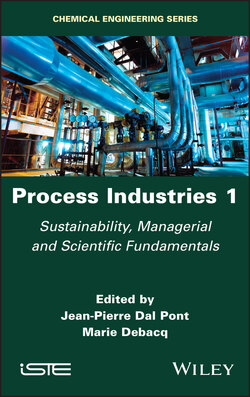Process Industries 1

Реклама. ООО «ЛитРес», ИНН: 7719571260.
Оглавление
Группа авторов. Process Industries 1
Table of Contents
List of Tables
List of Illustrations
Guide
Pages
Process Industries 1. Sustainability, Managerial and Scientific Fundamentals
Foreword by Laurent Baseilhac
Foreword by Vincent Laflèche
Foreword by June C. Wispelwey
Introduction
Notes
1. Industries, Businesses and People
1.1. Manufacturing, process, and service industries. 1.1.1. Manufacturing industries
1.1.2. Process industries
1.1.3. Service industries
1.2. Founding fathers of the industrial enterprise
1.3. Anatomy of an industrial enterprise
1.4. Industrial strategy: the business plan
1.4.1. Industrial strategy of the company
1.4.1.1. Business analysis
1.4.1.2. Analysis of the industrial facility
1.4.1.3. Definition and implementation of a strategic plan
1.4.1.4. Pareto analysis revisited
1.4.2. Business plan
1.4.3. Reengineering the corporation
1.5. Systemic vision of the enterprise: the enterprise and flows
1.6. The two operating modes of the enterprise: operational and entrepreneurial
1.7. Governance
1.8. Operations abroad
1.9. References
Notes
2. Earth, Our Habitat: Products by the Millions, the Need for Awareness
2.1. Population explosion
2.2. Systemic analysis and the concept of a system
2.3. Earth, a complex system
2.3.1. Atmospheric chemistry, ozone, and climate change
2.3.2. Water-energy-food-climate nexus
2.4. Awareness, sustainable development. 2.4.1. Rachel Carson and sustainability
2.4.2. Sustainable development
2.5. Products by the millions
2.6. Resource Earth, garbage Earth: towards a circular economy
2.6.1. Circular economy
2.6.2. Lifecycle assessment (LCA) and ecodesign
2.7. Materials science
2.8. Product formulation and engineering
2.9. Product toxicology and ecotoxicology
2.10. Product packaging and ergonomics
2.10.1. Packaging and packing/wrapping
2.10.2. Ergonomics
2.11. New consumer requirements
2.12. Boxes. Box 2.1.What is a Smart City? (Philippe Delarue)
Box 2.2.Lifecycle assessment for process ecodesign (Catherine Azzaro-Pantel)
Box 2.3.Managing the impact of chemical substances and products. Concepts of toxicology and ecotoxicology (Alain Lombard)
Box 2.4.Traceability: principles and applications (Jean-Michel Loubry)
Box 2.5.Recycling entrepreneurs at the heart of the circular economy: The special case of plastics (Jean-Philippe Carpentier)
Box 2.6.Biofuels: a response to energy transition (Thomas Mallet and Larissa Perotta)
2.13. References
Notes
3. Designing Chemical Products. 3.1. Introduction. 3.1.1. Why is chemical product design important?
3.1.2. Current state of the art
3.2. Basic technologies. 3.2.1. Dimensions
3.2.2. Additives
3.2.2.1. Starch
3.2.2.2. Gelatin
3.2.3. Microencapsulation
3.3. Products. 3.3.1. Aspirin®
3.3.2. Coffee and related beverages
3.4. Product design 4.0
3.5. References
Note
4. Chemical Engineering: Introduction and Fundamentals. 4.1. Introduction: definitions, history, and challenges
4.1.1. Introduction: definitions, history, and challenges
4.1.2. A crosscutting science serving society
4.1.3. Chemistry, formulation, industrial chemistry, chemical engineering, and product engineering
4.2. Fundamentals of chemical engineering
4.2.1. Thermodynamic fundamentals of chemical engineering
4.2.1.1. System, state, evolution, equilibrium, etc.: common words, but to be specified
4.2.1.2. Energy balance as a consequence of its conservation and transformation
4.2.1.3. Isobaric, isochore, isothermal, adiabatic, reversible processes
4.2.1.4. Entropy
4.2.2. Kinetic fundamentals of process design
4.2.2.1. Driving forces: the gradients at the basis of transfers
4.2.2.1.1. Heat transfer by conduction: Fourier’s law
4.2.2.1.2. Mass transfer by conduction: Fick’s law
4.2.2.1.3. Momentum transfer by conduction: Newton’s law
4.2.2.1.4. Kinetics of a reaction
4.2.2.2. Transfer coefficients. 4.2.2.2.1. Mass transfer coefficient
4.2.2.2.2. Heat transfer coefficient
4.2.2.2.3. Momentum transfer
4.2.2.2.4. Impact of the flow on transfer at an interface: calculation of transfer coefficients
Standard fluid versus laminar or turbulent flow
Relationship of transport phenomena to hydrodynamics - correlations
4.2.2.3 Chemical kinetics: what reaction rate and mechanism? 4.2.2.3.1. What reaction rate and mechanism?
4.2.2.3.2. Catalysis: accelerating and guiding a chemical reaction
4.2.3. System-balances-performance approach for process design
4.2.3.1. Example of a heat transfer device: water condenser in the secondary circuit of a nuclear power plant
4.2.3.2. Example of a reactor: denitrification tank of a wastewater treatment unit
4.2.4. Conclusion: ideal hydrodynamics and balances
4.3. Box
4.4. References
Note
5. Chemical Engineering: Unit Operations
5.1. Distillation
5.1.1. Vapor-liquid equilibria
5.1.2. Balances for a distillation column
5.1.3. McCabe-Thiele method
5.1.4. Technologies for continuous distillation
5.1.5. Conclusion on distillation
5.2. Fluid-solid mechanical separations
5.2.1. Fluid-solid interaction laws
5.2.2. Settling
5.2.3. Centrifugal and inertial separation. 5.2.3.1. Centrifugal decantation
5.2.3.2. Cyclones
5.2.4. Filtration
5.2.5. Conclusion on fluid-solid mechanical separations
5.3. Stirring
5.3.1. Qualitative aspects of stirring
5.3.2. Quantitative aspects of stirring
5.3.3. Choice of impellers
5.3.4. Stirred tank scale-up
5.3.5. Conclusion on stirring
5.4. Heat exchangers
5.4.1. Heat exchanger technologies
5.4.2. Designing heat exchangers
5.4.3. Conclusion on heat exchangers
5.5. Reactors
5.5.1. Conversion rate and generalized extent of reaction
5.5.2. Ideal homogeneous reactors
5.5.3. Non-ideal reactors
5.5.4. Multi-phase reactors
5.6. Conclusion
5.7. Boxes
5.8. Glossary
5.9. References
Notes
List of Authors
Index. A
B
C
D, E
F
G, H
I, L, M
P, Q
R
S
T
U, W
Summary of Volume 2
Other titles from. in Chemical Engineering. 2020
2019
2018
2017
2016
2015
2014
2012
2011
2010
WILEY END USER LICENSE AGREEMENT
Отрывок из книги
In memory of JeanneFor Pascal, Christian and CharlesJean-Pierre Dal Pont
.....
Figure 1.3. Principle of strategic analysis of a company (technical aspects). Establishing the strategic plan
.....